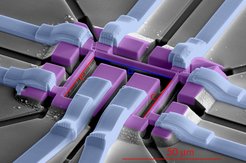Microstructured quantum matter
Mesoscale physics in strongly correlated electron systems, such as high-Tc superconductors, heavy fermion systems, unconventional superconductors (structure size 10 – 0.1µm)
Our main research interest is to understand “quantum materials” on the microscale, where quantum effects give rise to unusual electronic properties, with a particular focus on unconventional and high Tc superconductors and strongly correlated electron systems. Often collective states emerge due to strong electronic correlations and away from criticality these states are associated with a relevant physical length scale (e.g. coherence length in superconductors, domain sizes in density waves, …). We investigate how the electronic system changes as its physical dimension shrinks below that length scale.
This approach has two main goals: By accessing single-domain states, we hope to avoid the usual complications arising from the domain motion and structure in correlated systems and directly probe the intrinsic physics. Yet we are also interested in the application potential of novel materials for advances in electronics and technology. The nano- and micro-scale is the natural realm of modern electronics, so improving our understanding of the electric properties of novel materials on these length scales is an essential step towards their implementation into devices.
Experimentally, we develop new techniques to fabricate microstructures of highest crystalline quality for electric transport, magnetization, or heat capacity measurements based on Focused Ion Beam (FIB) micromachining. We use Ga- and Xe-ion beams to carve microstructures with typical dimensions between 10 – 0.1µm from mm-sized as-grown crystalline material. The gentle cutting process uses low energy ions (typically 60keV), thus limiting material damage to a thin surface layer. We confirm the high crystalline quality of our samples regularly by X-ray diffraction and quantum oscillation measurements. Thus FIB machining enables the machining of three dimensional mesoscale structures of single crystalline material.
Our research is at the interface between physics, chemistry and materials science, and thus our efforts are naturally collaborative. We form strong international collaborations with material synthesis experts around the world, and benefit from the materials science expertise at our host institute. Many of our projects require extreme magnetic fields, and thus we have a strong collaboration with the National High Magnetic Field Laboratory in the US.
We are always interested in new materials and challenging experiments. For additional information on our group and microstructuring, please also visit us at www.miquamat.de.

